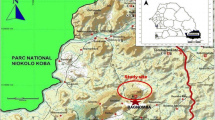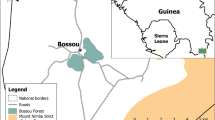Surplus chimpanzees live in research laboratories where they will likely remain for the rest of their lives. An alternative to laboratory housing is an outdoor enclosure in a warm climate. Before construction, researchers should conduct a vegetation survey because chimpanzees use vegetation daily. Chimp Haven, Inc. is developing a chimpanzee sanctuary in Caddo Parish, Louisiana, and we conducted a vegetation survey at the site to 1) characterize the abundance and structure of vegetation; 2) identify plants with utility as food, nesting material, or tools; 3) determine the abundance and distribution of useful vegetation; and 4) identify any possibly hazardous vegetation. We established 48 plots, quantified the woody vegetation, and identified potentially useful and hazardous plant species from the published literature. Vegetation at the site was secondary growth from logging of loblolly pine (Pinus taeda), the most abundant tree. Other abundant trees included oak (Quercus spp.), elm (Ulmus spp.), sweetgum (Liquidambar styraciflua), and maple (Acer spp.). Small plants (1–9.9 m tall) constituted 95% of all vegetation. Forty-one of 64 plant species have edible vegetative parts, while 35 species have edible reproductive parts. We identified 55 potential nesting trees by size (dbh ≥ 25 cm) and 4 species used as tools by captive great apes. Useful vegetation was concentrated in areas with topographic relief or in a floodplain, while flat areas with fields had less. We recommend that the floodplain be cropped for fruit and browse and enclosures encompass areas with relief and fields, creating a diverse habitat.



Similar content being viewed by others
REFERENCES
Association of Zoological Horticulture Information and Survey Committee (AZH). (1998). Animal browse survey. AZH, New York.
Baldwin, P. J., Sabater Pi, J., McGrew, W. C., and Tutin, C. E. G. (1981). Comparisons of nests made by different populations of chimpanzees (Pan troglodytes). Primates 22: 474–486.
Brent, L. (2000). The future of long-term chimpanzee care: an update. Lab Anim. Jan. 51–55.
Brent, L. (2004). Solutions for research chimpanzees. Lab Anim. Jan. 37–43.
Brent, L., Butler, T. M., and Haberstroh, J. (1997). Surplus chimpanzee crisis: planning for the long-term needs of research chimpanzees. Lab Anim. Oct. 36–69.
Dirr, M. A. (1998). Manual of woody landcape plants: their identification, ornamental characteristics, culture, propagation and uses. Stipes, Champaign, IL.
Dyke, B., Williams-Balngero, S., Mamelka, P. M., and Goodwin, W. J. (1995). Future costs of chimpanzees in U.S. research institutions. Inst. Lab. Animal Res. J. 37: 193–198.
Foster, S., and Duke, J. A. (1990). Peterson field guides: eastern/central medicinal plants. Houghton Mifflin, Boston.
Fruth, B., and Hohmann, G. (1994a). Comparative analyses of nest building behavior in bonobos and chimpanzees. In Wrangham, R. W. et al. (eds.), Chimpanzee cultures, Harvard University Press, Cambridge, pp. 109–128.
Fruth, B., and Hohmann, G. (1994b). Nests: living artefacts of recent apes? Curr. Anthropol. 35: 310–311.
Fruth, B., and Hohmann, G. (1996). Nest building in the great apes: the great leap forward? In McGrew, W. C., Marchant, L. F., and Nishida, T. (eds.), Great ape societies, Cambridge University Press, Cambridge, pp. 225–239.
Goodall, J. (1962). Nest building behavior in the free ranging chimpanzee. Ann. NY Acad. Sci. 102: 455–467.
Goodall, J. (1968). The behaviour of free-living chimpanzees in the Gombe Stream Reserve. Anim. Behav. Mono. 1: 161–311.
Hardin, J. W., and Arena, J. M. (1969). Human Poisoning from Native and Cultivated Plants. Duke University Press, Durham.
Hitchcock, A. S. (1971). Manual of the grasses of the United States, Vol. 1, 2nd ed, reprinted, Dover Pub., New York.
Hladik, C. M. (1977). Chimpanzees of Gabon and chimpanzees of Gombe: some comparative data on the diet. In Clutton-Brock, T. H. (ed.), Primate Ecology: Studies of Feeding and Ranging Behaviour in Lemurs, Monkeys and Apes. Academic Press, London, pp. 481–501.
Hunt, K. D., and W. C. McGrew. (2002). Chimpanzees in the dry habitats of Assirik, Senegal and Semliki Wildlife Reserve, Uganda. In Boesch, C., Hohmann, G., and L. F. Marchant (eds.). Behavioural Diversity in Chimpanzees and bonobos. Cambridge University Press, Cambridge, pp. 35–51.
Little, E. L. (1997). National Audobon Society field guide to North American trees. Alfred A. Knopf, New York.
McGrew, W. C. (1992). Chimpanzee material culture: implications for human evolution. Cambridge University Press, Cambridge.
McGrew, W. C., Baldwin, P. J., and Tutin, C. E. G. (1988). Diet of wild chimpanzees (Pan troglodytes verus) at Mt. Assirik, Senegal: I. composition. Am. J. Primatol. 16: 213–226.
McGrew, W. C., and Tutin, C. E. G. (1973). Chimpanzee tool use in dental grooming. Nature 241: 477–478.
McGrew, W. C., Tutin, C. E. G, and Midgett, P. S. (1975). Tool use in a group of captive chimpanzees. I. Escape. Z. Tierpsychol. 37: 145–162.
Medsger, O. P. (1966). Edible wild plants. MacMillan, New York.
Nash, V. J. (1982). Tool use by captive chimpanzees at an artificial termite mound. Zoo. Biol. 1: 211–221.
Nishida, T., and Uehara, S. (1983). Natural diet of chimpanzees (Pan troglodytes schweinfurthii): Long term record from the Mahale Mountains, Tanzania. Afr. Stud. Mono. 3: 109–13.
Peterson, L. A. (1977). Peterson field guides: a field guide to edible wild plants of eastern and central North America. Houghton Mifflin, Boston.
Pruetz, J. D. E, and McGrew, W. C. (2001). What does a chimpanzee need? Using natural behavior to guide the care of captive populations. In Brent, L.. (ed.), The Care and Management of Captive Chimpanzees. American Society of Primatology, pp. 17–37.
Ron, T., and McGrew, W. C. (1988). Ecological assessment for a chimpanzee rehabilitation project in northern Zambia. Primate Conserv. 9: 37–41.
Sugiyama, Y., and Koman, J. (1987). A preliminary list of chimpanzees’ alimentation at Bossou, Guinea. Primates 28: 133–147.
Tutin, C. E. G., and Fernandez, M. (1993). Composition of the diet of chimpanzees and comparisons with that of sympatric lowland gorillas in the Lope Reserve, Gabon. Am. J. Prim. 30: 195–211.
Wrangham, R. W. (1977). Feeding behaviour of chimpanzees in Gombe National Park, Tanzania. In Clutton-Brock, T. H. (ed.), Primate Ecology: Studies of Feeding and Ranging Behaviour in Lemurs, Monkeys and Apes. Academic Press, London, pp. 503–538.
Acknowledgments
We thank Larry Raymond, Gerry Goodwin, Robert Simmons, and the staff at the Forcht Wade Correctional Center for their assistance in Caddo Parish; Dr. Steven Lynch for use of his research facilities; Dr. Michael Vincent for help with plant identification and useful comments on the manuscript; Dr. David Gorchov for help with data analysis; Dr. Roger Meicenheimer for providing the MUDES tree data base; Dr. David R. Vann and Dr. Bryan Endress for useful comments on the manuscript; and Dr. Juliana Fort and the late Mr. Percy Sharp for facilitating our stay in Shreveport. This research was funded by a Rebecca Jeanne Andrew Memorial Award from Miami University.
Author information
Authors and Affiliations
Corresponding author
Rights and permissions
About this article
Cite this article
Horvath, J.L., Croswell, M., O’Malley, R.C. et al. Plant Species with Potential as Food, Nesting Material, or Tools at a Chimpanzee Refuge Site in Caddo Parish, Louisiana. Int J Primatol 28, 135–158 (2007). https://doi.org/10.1007/s10764-006-9106-4
Published:
Issue Date:
DOI: https://doi.org/10.1007/s10764-006-9106-4




